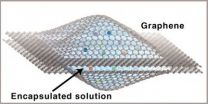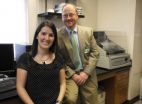(Press-News.org)
VIDEO:
In this first ever atomic-scale real-time movie of nanocrystal growth in liquid, which was made at TEAM I of the National Center for Electron Microscopy, nanoparticles of platinum move and...
Click here for more information.
They won't be coming soon to a multiplex near you, but movies showing the growth of platinum nanocrystals at the atomic-scale in real-time have blockbuster potential. A team of scientists with the Lawrence Berkeley National Laboratory (Berkeley Lab) and the University of California (UC) Berkeley has developed a technique for encapsulating liquids of nanocrystals between layers of graphene so that chemical reactions in the liquids can be imaged with an electron microscope. With this technique, movies can be made that provide unprecedented direct observations of physical, chemical and biological phenomena that take place in liquids on the nanometer scale.
"Watching real-time chemical reactions in liquids at the atomic-scale is a dream for chemists and physicists," says Jungwon Park, a member of the team who holds joint appointments with Berkeley Lab's Materials Sciences Division and UC Berkeley's chemistry department. "Using our new graphene liquid cell, we're able to capture a small amount of liquid sample under a high vacuum condition for taking real-time movies of nanoparticle growth reactions. Since graphene is chemically inert and extremely thin, our liquid cell provides realistic sample conditions for achieving high resolution and contrast."
Park was the lead author, along with Jong Min Yuk, of a paper in the journal Science that describes this research titled "High-Resolution EM of Colloidal Nanocrystal Growth Using Graphene Liquid Cells." The research was done as a collaboration between the research groups of Paul Alivisatos, director of Berkeley Lab and UC Berkeley's Larry and Diane Bock Professor of Nanotechnology, and Alex Zettl, who holds joint appointments with Berkeley Lab's Materials Sciences Division and UC Berkeley's Physics Department where he directs the Center of Integrated Nanomechanical Systems. Both are corresponding authors of the Science paper along with Jeong Yong Lee of Korea's Advanced Institute of Science and Technology (KAIST). Other authors were Peter Ercius, Kwanpyo Kim, Daniel Hellebusch and Michael Crommie.
In using a beam of electrons rather than a beam of light for illumination and magnification, electron microscopes can "see" objects hundreds and even thousands of times smaller than what can be resolved with an optical microscope. However, electron microscopes can only operate in a high vacuum as molecules in the air disrupt the electron beam. Since liquids evaporate in high vacuum, liquid samples must be hermetically sealed in special solid containers – called cells – with a viewing window before they can be imaged in an electron microscope. Until now, such liquid cells have featured viewing windows made from silicon nitride or silicon oxide. While this has permitted studies of some nanoscale phenomena in liquids, the silicon-based cell windows are too thick to allow strong penetration by the electron beam and this has limited resolution to only a few nanometers. In addition to not allowing true atomic-resolution, the thick silicon-based cell windows also appear to perturb the natural state of the liquid or sample suspended in the liquid.
"Graphene is single carbon atom in thickness, making it one of the thinnest known membranes," says Park, a member of the Alivisatos' research group. "It does not scatter the electron beam but lets it pass through. Furthermore, graphene is also very strong and impermeable, as well as being chemically non-reactive, and this helps protects the sample in the liquid cell from the high-energy beam of an electron microscope."
To make their graphene liquid cell, the Alivisatos-Zettl collaboration encapsulated a platinum growth solution between two laminated graphene layers that were suspended over holes in a conventional transmission electron microscope (TEM) grid. The graphene was grown on a copper foil substrate via chemical vapor deposition and then directly transferred onto a gold TEM mesh with a perforated amorphous carbon support. The platinum growth solution was pipetted directly atop two graphene-coated TEM grids facing in opposite directions.
"Upon wetting the system, the solution wicks between the graphene and amorphous carbon layers, allowing one of the graphene sheets to detach from its associated TEM grid," says co-author Kim, a member of the Zettl research group. "Because the van derWaals interaction between graphene sheets is relatively strong, liquid droplets ranging in thickness from six to 200 nanometers can be securely trapped in a pocket or blister between the graphene sheets."
To test their graphene liquid cells, the collaborators used the world's most powerful electron microscope, the TEAM I at the National Center for Electron Microscopy (NCEM), which is housed at Berkeley Lab. TEAM stands for Transmission Electron Aberration-corrected Microscope and the TEAM I instrument is capable of producing images with a half-angstrom resolution, which is less than the diameter of a single hydrogen atom. With TEAM I and their new graphene liquid cells, the Alivisatos-Zettl collaboration was able to directly observe at the highest resolution possible to date and with minimal sample perturbation, the growth of nanocrystals of platinum, one of the best metal catalysts in use today.
"Direct atomic-resolution imaging allowed us to visualize critical steps in the platinum nanocrystal growth process, including a host of previously unexpected phenomena, such as
site-selective coalescence, structural reshaping after coalescence, and surface faceting," says Park.
Three years ago, Park and Alivisatos were part of a team that used another TEM at NCEM and liquid cells featuring silicon nitride windows to record the first ever images of colloidal platinum nanocrystals growing in solution at subnanometer resolution. Their results showed that while some crystals in solution grew steadily in size via classical nucleation and aggregation – meaning molecules collide and join together – others grew in fits and spurts, driven by "coalescence events," in which small crystals randomly collide and fuse together into larger crystals. Despite their distinctly different growth trajectories, these two processes ultimately yielded nanocrystals of approximately the same size and shape.
"In that earlier study, however, we lacked the resolution to fully understand how these nanoparticles merge and reorganize their shape in the coalescence growth trajectory," Park says. "With the graphene liquid cells we used in this study, we were able to resolve the oriented coalescence along a specific crystal direction and see how they reorganized their overall structure into a final shape."
With the graphene liquid cells and the greater resolution of TEAM I, the Alivisatos-Zettl collaboration was able to observe that most coalescence events proceed along the same crystallographic direction – the {111} plane of the crystal. This points to a specific nanocrystal orientation for coalescence not seen before in metal nanoparticles.
"We were able to resolve atomistic arrangement at the moment two of the platinum nanoparticles merged and visualize oriented attachment, a phenomenon known to be one the of major growth mechanisms of anisotropic particles," Park says. "This oriented coalescence could be one of the formation mechanisms behind another phenomenon we observed, twin boundaries, which occurs when nanoparticles merge together along the same {111} direction but on a mirror plane in the crystal."
In the future, the collaborators plan to use their graphene liquid cells to study the growth of many different types of nanoparticles, including metals, semiconductors and other useful materials. The graphene cells could also be applied to biomaterials, such as DNA and proteins, which exist naturally in solution.
"The one atom thick graphene membranes are ideal for liquid encapsulation," says co-author Ercius, the NCEM staff member who ran the TEAM I microscope for this study. "When combined with the aberration corrected imaging of TEAM I, we can reach the ultimate in image contrast and resolution for in-situ liquid experiments. The graphene liquid cell technique could be easily applied to other electron microscopes and I think it will become instrumental in answering questions regarding the synthesis of materials in liquids at the atomic scale."
INFORMATION:
This work was supported by the U.S. Department of Energy's Office of Science, and in part through the National Research Foundation of Korea.
Lawrence Berkeley National Laboratory addresses the world's most urgent scientific challenges by advancing sustainable energy, protecting human health, creating new materials, and revealing the origin and fate of the universe. Founded in 1931, Berkeley Lab's scientific expertise has been recognized with 13 Nobel prizes. The University of California manages Berkeley Lab for the U.S. Department of Energy's Office of Science. For more, visit www.lbl.gov.
First atomic-scale real-time movies of platinum nanocrystal growth in liquids
Berkeley Scientists Create Graphene Liquid Cells for Electron Microscopy Studies of Nanocrystal Formation
2012-04-21
ELSE PRESS RELEASES FROM THIS DATE:
Madison, WI Dentist Makes Receiving Dental Care Easier With New Online Feature
2012-04-21
Well-known Madison, WI dentist, Dr. Liberty Boucher, is pleased to announce the newest addition to Odana Hills Dental's website- online appointment requesting. The new feature will enable patients to make an appointment with ease, giving them the flexibility to request an appointment at their convenience from the comfort of their home computers.
Odana Hills Dental is a full-service dental practice located in Madison, WI and serves patients in the surrounding communities. With a focus on patient education, comfort and quality care, Odana Hills Dental offers an array ...
Anti-tobacco TV ads help adults stop smoking, study finds
2012-04-21
Anti-tobacco television advertising helps reduce adult smoking, according to a study by researchers at the University of Illinois at Chicago's Institute for Health Research and Policy -- but some ads may be more effective than others.
Adults and youth are exposed to a variety of anti-smoking messages on television. However, no research had been done on whether the ads, produced by various sponsors, impact adult smoking behaviors, or on how the ads differ, says Sherry Emery, a senior scientist at the UIC institute and lead author of the study.
The new study, in the April ...
Scientists show how social interaction and teamwork lead to human intelligence
2012-04-21
Scientists have discovered proof that the evolution of intelligence and larger brain sizes can be driven by cooperation and teamwork, shedding new light on the origins of what it means to be human. The study appears online in the journal Proceedings of the Royal Society B and was led by scientists at Trinity College Dublin: PhD student, Luke McNally and Assistant Professor Dr Andrew Jackson at the School of Natural Sciences in collaboration with Dr Sam Brown of the University of Edinburgh.
The researchers constructed computer models of artificial organisms, endowed ...
Cellular pathway linked to diabetes, heart disease
2012-04-21
CINCINNATI—Cardiac researchers at the University of Cincinnati (UC) have found that a certain cellular pathway is linked to obesity-related disorders, like diabetes, heart disease and fatty liver disease.
These findings, being presented at the American Heart Association's Arteriosclerosis, Thrombosis and Vascular Biology (ATVB) 2012 Scientific Sessions in Chicago, April 19, 2012, could lead to a potential molecular target for metabolic diseases in humans.
Building on previous research, Tapan Chatterjee, PhD, and researchers in the division of cardiovascular diseases ...
19th century therapy for Parkinson's disease may help patients today
2012-04-21
(CHICAGO) – In the 19th century, Jean-Martin Charcot, the celebrated neurologist, developed a "vibration chair," to relieve symptoms of Parkinson's disease. Charcot reported improvements in his patients, but he died shortly thereafter and a more complete evaluation of the therapy was never conducted. Now, a group of neurological researchers at Rush University Medical Center have replicated his work in a study to see if Charcot's observation holds true against modern scientific testing.
Results from the study indicate that while vibration therapy does significantly improve ...
New study links air pollution and early death in the UK
2012-04-21
CAMBRIDGE, Mass. -- In a study appearing this month in the journal Environmental Science and Technology, MIT researchers report that emissions from cars, trucks, planes and powerplants cause 13,000 premature deaths in the United Kingdom each year.
The researchers analyzed data from 2005, the most recent year for which information is available. They found that among the various sources of emissions in the country, car and truck exhaust was the single greatest contributor to premature death, affecting some 3,300 people per year. By comparison, the researchers note, fewer ...
$9 million grant awarded to UH to study, treat learning disabilities
2012-04-21
The National Institutes of Health (NIH) has awarded a five-year, $9 million grant to the University of Houston's Texas Center for Learning Disabilities to conduct research on the causes and treatment of learning disabilities in children and adolescents. UH is one of four universities nationally to receive funding from the NIH for a learning disability research center.
The substantial number of today's adolescents struggling with weak literacy skills presents an urgent national concern, yet little is known about reading disabilities beyond the early elementary grades. ...
MyBinding.com Partners with Local Gym Boom Fitness to Provide an Employee Fitness Program
2012-04-21
MyBinding.com, one of the country's leading retailers of document finishing machines and supplies, is partnering with Boom Fitness to provide their employees with a fitness program.
"The health of our employees is very important to us," said Jeff McRitchie, Vice President of Marketing for MyBinding.com. "Many of our employees sit for most of the day and we wanted a way to help our staff stay active."
McRitchie joined Boom Fitness for personal reasons and brought several employees along with him. As more employees joined, the two companies decided ...
Lizard moms may prepare their babies for a stressful world
2012-04-21
Stressed out lizard moms tend to give their developing embryos short shrift, but the hardship may ultimately be a good thing for the babies once they're born, according to a study published in the journal Physiological and Biochemical Zoology.
Stress changes the way animals allocate energy. During predator attacks or food shortages, hormones are released that help the body to access stored energy. But for pregnant females there's a potential trade-off. Stress hormones could rob precious energy from developing embryos, leading to offspring that aren't as healthy.
A research ...
Concerns about MRSA for expectant mothers may be unfounded
2012-04-21
The need to swab the noses of pregnant women and newborns for the presence of MRSA (methicillin-resistant Staphylococcus aureus) may be unfounded, according to a Vanderbilt study now available online and published in the May issue of Pediatrics.
The study's senior author, Buddy Creech, M.D., MPH, assistant professor of Pediatrics, said it is often feared that mothers carrying MRSA may risk transmitting an infection to their newborn babies, but Vanderbilt Pediatric Infectious Diseases researchers found that babies rarely became ill from MRSA infections, despite frequently ...
LAST 30 PRESS RELEASES:
Archaeologists use AI to create prehistoric video game
Mitochondria migrate toward the cell membrane in response to high glucose levels
Tiny viral switch offers hope against drug-resistant bacteria
Most parents aware of early peanut introduction guidelines, but confused about details
HPV vaccine can protect against severe lesions of the vulva and vagina
Virtual care provision and emergency department use among children and youth
Quadrivalent HPV vaccine and high-grade vulvovaginal lesions
Insights into dry eyes gained from stem cell-derived tear glands
Researchers identify 166 human pluripotent stem cell lines available for use in clinical applications
Europa Clipper instrument uniquely observed interstellar comet 3I/ATLAS
UN University Report challenges climate change as sole trigger of Syrian Civil War, exposing governance failures in drought response
Real estate investment trust (REIT) acquisition associated with hospital closure and bankruptcy
New Raman imaging system detects subtle tumor signals
Boston Children’s receives a $7.5 million grant from Aligning Research to Impact Autism (ARIA) to provide clinical research coordination for the IMPACT Network
Spray-on antibacterial coating offers new protection for plants against disease and drought
ESMT Berlin study: What makes a first offer successful in negotiations
Groundbreaking ceremony marks the beginning of CTAO-South Array construction in Chile
Why swearing makes you stronger
What prevents more cancer patients from enrolling in potentially life-saving clinical trials?
UK’s worst-case climate risks laid bare for lawmakers
A decline in churchgoing linked to more deaths of despair
TAMEST announces Maralice Conacci-Sorrell, Ph.D., UT Southwestern Medical Center, as 2026 Mary Beth Maddox Award & Lectureship Recipient
Global study to evaluate whether dengue outbreaks can be anticipated earlier
Chonnam National University researchers propose innovative voltage-loop control for power factor correction
Accelerating next-generation drug discovery with click-based construction of PROTACs
Detecting the hidden magnetism of altermagnets
$7M gift supports health research, engineering and athletics at UT San Antonio
NU-9 halts Alzheimer’s disease in animal model before symptoms begin
Hospitals acquired by real estate investment trusts associated with greater risk of bankruptcy, closure
City of Hope scientists study rare disorder to uncover mechanism and hormone regulation underlying fatty liver disease and sweet aversion
[Press-News.org] First atomic-scale real-time movies of platinum nanocrystal growth in liquidsBerkeley Scientists Create Graphene Liquid Cells for Electron Microscopy Studies of Nanocrystal Formation



